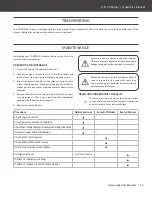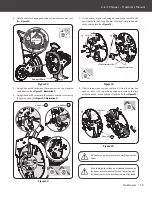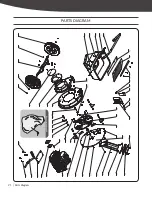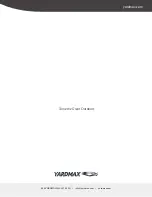
IDLE SPEED
Set the lever to the SlOW position to reduce stress on the engine
when chipping is not being performed. lowering the engine speed
will help extend the life of the engine, as well as conserve fuel and
reduce noise level.
STOP ENGINE
To stop the engine, use the following procedure:
1. Move the lever to stop position.
2. Close fuel shut-off valve.
Make sure the machine is level and stable to avoid
unnecessary vibrations.
Do not operate on concrete or other hard surface.
Do not open the housing cover unless the engine and
cutting disk are completely stopped.
To shut down the machine, move the lever to idle
speed, and it will gradually come to a standstill.
Sudden stopping at a high speed under a heavy load
is not recommended. Engine damage may result.
Wait until the machine completely stops. Allow the engine to
completely cool. Remove the engine’s spark plug. Then clean out
the interior of the machine and its discharge chute.
The chipper can clog up with soft, wet, or fibrous materials.
However, if you feed soft materials intermittently with branches,
there should be no problem, as the chipper tends to clean out any
residue left in the machine.
If any stringy material wraps around the rotor shaft, remove it
before it works its way into the bearing.
If the chipper stalls from overloading or clogging, turn off the
engine’s power switch and wait until the cutting disk is completely
stopped. Allow the engine to completely cool and switch the
engine to off. Open the housing cover to clear and remove all the
materials from the housing. lock the housing cover, switch the
engine to the on position, and start the machine again to resume
operation.
As the discharge material plies up, move the chipper away from
the pile. This will keep the material from backing up the discharge
chute. Do not position the deflector vertically, as this will reduce
the airflow, impeding the discharge and causing blockage.
Feed tree limbs or branches with the cut end first into the hopper
opening, leaving the brushy head to be chipped last. This helps
guide the limb down the feed hopper opening and reduces the
chance of cut pieces being toss back up the hopper opening. Some
branches may be required to be pre-cut to provide the a more
efficient self-feeding action.
It is recommended to process freshly cut materials, as older
branches get dried out and brittle. Older, dryer branches will dull
the cutting knifes quicker than freshly cut ones.
While operating the machine, keep a wooden stick handy,
approximately 1 inch in diameter by 2 feet long. This stick will be
useful to push in short, brushy and very leafy materials and keep
the feed hopper clear.
Do not force material into the machine. If it does not chip well, the
chipper knives may need sharpening or to be replaced.
Do not overload the machine by filling the hopper opening with
too much material at one time. As a load passes through the
cutting disc and is discharged, the engine speed may decrease.
Allow enough time for the engine to accelerate to the highest RPM
before another load is added. In the event of overload condition,
stop feeding material into the hopper.
Chipper Cone
Feed Hopper
NO HANDS BELOW THIS LINE
This chipper can process tree limbs, branches, and organic matter
(such as corn stalks). Tree branches must be inserted with the
large, cut end first into the Chipper Cone Opening. As the unit
chips the load, there will be some occasional debris kickback.
Always stand away from the unit and allow the self-feeding action
pull the load to the cutting disc.
The chipper shredder is designed to break down and shred light
brush, leaves, and soft but bulky organic waste. load this type of
material (no larger than ½” in diameter) into the top of the Feed
Hopper. The material is then pulled into the cutting chamber by
air flow.
15
|
Operation
36060US25M100_KOHLER.indd 15
2017/10/17 11:06:12























